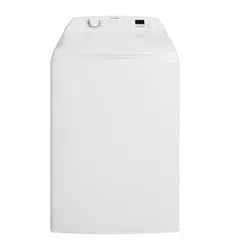Documents: Go to download!
User Manual
- Owner's manual - (English)
- SWT1154DCWA - Simpson - Specifications Sheet - (English)
- PRODUCT DESCRIPTION
- ABOUT YOUR WASHING MACHINE
- CONTROL PANEL
- WASHING INSTRUCTIONS
- DAILY USE
- HELPFUL HINTS IN DEALING WITH WASHING PROBLEMS
Table of contents
User Guide
PRODUCT DESCRIPTION
WASHING MACHINE PARTS **SWT8043, SWT8063E, SWT9043, SWT1043 SWT1154DCWA
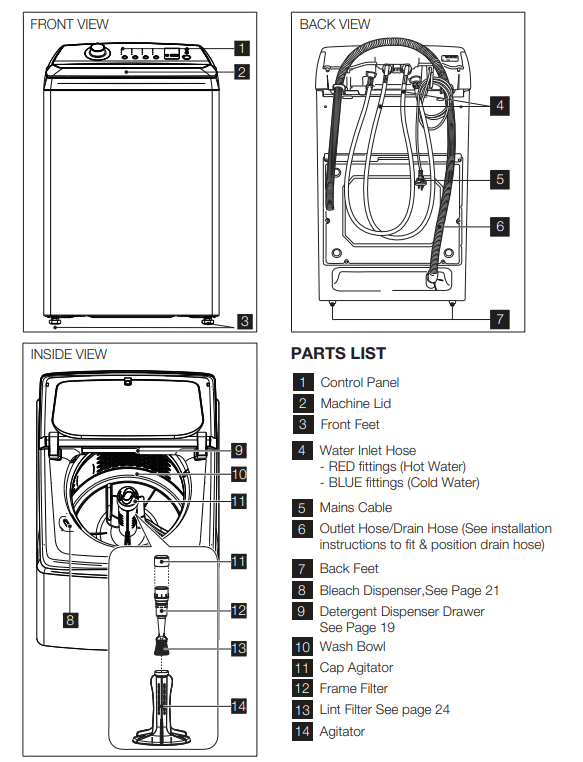
WASHING MACHINE PARTS **SWT9043A , SWT1023A, SWT1254LCWA

ABOUT YOUR WASHING MACHINE
- The out of balance has 2 level which are low level and high level.
- The high level: Machine will be stopped, caused by an uneven distribution of clothes in the wash bowl. To rectify the out of balance condition, open the lid and redistribute the clothes evenly in the wash bowl. Closing the spin stage of the wash.
- The low level: The washing machine try to optimize by reduce spin speed to avoid out of balance to finish the cycle.
- If you have frequent out of balance interruptions, it may be due to your washing machine not standing firm and level on the floor. This can be corrected by adjust the washing machine legs as described in the Installation Instructions supplied with your machines.
ABOUT YOUR WASHING MACHINE
- Out of Balance Interruption
- Watch the lights on the control panel to see the effect pressing a touchpad or turning a program selector knob has, and listen for BEEPS”.
- When you press a touchpad you will get a short “BEEP” to acknowledge the entry.
- If the option is not available at the time, the machine will not allow you to select it. After the machine has started, the entire wash option touchpad will be disabled and machine will give three short beeps to indicate the touchpad is disabled. The Star/Pause To
- Pause touchpad is still active but you need to press and hold the touchpad for minimum 1.2 seconds to pause machine.
- This is to confirm that you really want to pause the machine.
NOTE:
- All functions of the washing machine will stop when the lid is open.
ActiveBoost™
- This product features the new ActiveBoost
- Wash System that uses less amount of water, and is more energy efficient,during the washing process. It achieves this with just the right amount of water needed, and by a detergent pre-mixing system that minimizes detergent residue even during cold wash to give you a cleaner wash result.
- Water at 35 C is combined with detergent to dissolve and activate it. Depending on model, this concentrated solution is then circulated or showered over the clothes in combination with unique bowl and agitator rotations to provide wash action at the selected wash temperature.
- After the wash operation is completed, the bowl is filled with more water. The low profile agitator or agitator then moves in an energy efficient mode, generating additional mechanical actions.
Your washing machine has selectable
- Auto” sensing water level option as well as allowing you to choose a manual water level if you wish. We recommend you to use the Auto water level option to ensure there is just the right amount of water for the wash load in the machine.
- In other words, it will usually give you the best wash while also being the most efficient in terms of water usage.
- Auto Water Level Feature
Wash Operation
- Agitation water spraying pump on water spraying drain hose pump on drain hose
- Touchpad Response and Lights
- Always press touchpads gently.
CONTROL PANEL
8 Kg. SWT8043, SWT8063E

9 Kg. SWT9043 / 11 Kg. SWT1154DCWA / 12 Kg. SWT1254LCWA
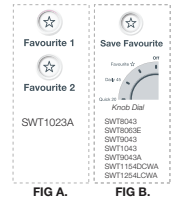
10 Kg. SWT1043

PROGRAM SELECTOR KNOB
- Turn the Program Selector knob to choose the wash program you want. The table “Your Program
- Guide” shown on page 16 will help you in selecting the right program.
- The Program Selector knob is not a timer. Once you select a wash program, the Program Selector knob will stay at that position for the whole wash cycle.
WATER TEMPERATURES BUTTON
- For each wash program your washing machine automatically selects a suitable fill water temperature. If you want to use a different wash water temperature, press the Temperature button repeatedly.
- The temperature of warm water will depend on the temperature and pressure of your hot and cold water supplies. The recommended temperature for warm is 35°C.
- You have four temperatures to choose from Very
Hot, Hot, Warm and Cold.
- The water temp lights will tell you the temperature for each press of the button.
NOTE:
- If you have a cold water connection
- ONLY and the hot inlet valve is capped off (refer installation instructions) you must select Cold washes only. To fill detergent, you must follow steps as below:
- Measure the correct amount of powder detergent by following the recommendations on the package.
- Mix powder detergent in one litre of hot or warm water.
- Add the pre-mixed detergent to the wash load.
CHOOSE THE WATER LEVEL
- Choose the water level by pressing Water Level touchpad.
- You can select:
- Use only the amount of water you need for the wash load.
- Auto level: the exact water level required to wash your clothes effectively is determined and set for you automatically, ensuring no water is wasted.)
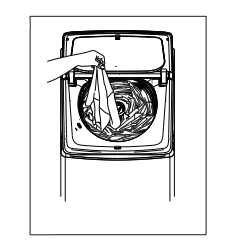
RINSE OPTION BUTTON
- When Eco rinse is used, rinse water is sprayed into the washbowl in pulses.
- After each pulse the washbowl will spin to remove detergent laden water from the clothes.
- How does Eco Rinse work ?
- There are four rinses to choose from...
- Fast rinse, Eco rinse, Deep rinse and
Extra rinse.
- Extra : Extra rinse, the machine fills twice, giving you two deep rinses.
- Deep : Deep rinse the machine fills once, giving you one deep rinse.
- Eco : Eco rinse is a spray rinse giving you maximum water saving.
- Fast : Fast rinse uses less time then Eco rinse by performing only 3 Eco sprays but the amount of water in each spray is increased.
WASH CYCLE IN PROGRESS

- After selecting a program, the duration is displayed in hours and minutes for example 2:34 which means 2 hour and 34 minutes)
- The duration is calculated automatically on the basis of the maximum recommended load for each type of fabric.
- After the program has started, the time remaining is updated every minute.
- When the wash program is completed, the display shows text <FINISHED> or END> .
- The Start/Pause button LED will turn Off.
- The Start/Pause button LED will always light not blink) to indicate that now machine is in executing mode.
LID LOCK FEATURE
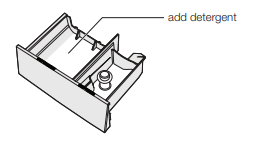
- This is a safety feature so as to prevent anyone from opening the door lid when
- Except SWT8043, SWT8063E) the drum is spinning.
- To unlock the lid, user needs to tap
- Start / Pause] button once to pause the appliance and the display will turn Off the lid lock icon.
- The mechanical lock unlocks when the
- The Lid Lock indicator will light up when the feature activate drum stops spinning.ENABLING/DISABLING END OF
WASH BEEP
- User can also disable the buzzer by pressing the [Water Level] button + [Spin] button down for 3 sec and release.
- The volume level is set in the factory and cannot be adjusted by the user.
MACHINE IN PAUSE MODE
- User needs to touch [Start / Pause] button once to pause the appliance.
- Under the remaining time is show text <PAUSE>
START/PAUSE BUTTON
- After selecting a program, the duration is displayed in hours and minutes for example 2:34 which means 2 hour and 34 minutes)
- The duration is calculated automatically on the basis of the maximum recommended load for each type of fabric.
- After the program has started, the time remaining is updated every minute.
- When the wash program is completed, the display shows text <FINISHED> or
- The Start/Pause button LED will turn Off.
- The Start/Pause button LED will always light not blink) to indicate that now machine is in executing mode.
LID LOCK FEATURE
- This is a safety feature so as to prevent anyone from opening the door lid when
- Except SWT8043, SWT8063E) the drum is spinning.
- To unlock the lid, user needs to tap
- Start / Pause] button once to pause the appliance and the display will turn Off the lid lock icon.
- The mechanical lock unlocks when the
- The Lid Lock indicator will light up when the feature activate drum stops spinning.
- Press the Start/Pause button to Pause.
- Start/Pause to Pause is used to Start,
- Stop and Continue the wash.
- If you have started your wash and you wish to stop it for some reason, press the
- Start/PauseTo Pause touchpad and hold it for 1.2 secounds to enter pause mode
FAVOURITE

- The favourite function is the ability to tailor individual wash features and save them as a custom programme until the next time.
- FIG A : Select the Favourite 1 or 2, choose wash method, spin , temperature ,Rinse, then touch and hold the Favourite button for seconds .“Beep sound”is activated and the programme is stored for later use with a single button press.
- Select the Save Favourite, choose wash method, spin , temperature ,Rinse, then touch and hold the Favourite button for seconds .“Beep sound”is activated and the programme is stored for later use with select Favourite program on Knob Dial.
WASHING INSTRUCTIONS
- These Washing Instructions are of a general nature and you should get good wash results by following them.
- However, due to the variables of fabric types, soil levels, detergent types and available program settings you may find some combinations of these which do not always result in the perfect wash.
- If for example you see residuals of detergent or soils on some items, please read the section Residues on washed items paragraph.
- Over time you will learn what is the best set-up of programs, detergent and load sorting for different load types and soils.
SORT YOUR WASHING INTO SEPARATE WASH LOADS

- Each load of washing should contain clothing which needs the same washing conditions. For example, you should not wash delicate clothes with very dirty work clothes.
- Colour fast and non-colourfast fabrics should be separated.
- Knowing the type of fabrics you have and how dirty they are will help when you make selections from the wash program options.
- Some fabrics are lint collectors and can pick up lint, dirt and colour from other fabrics which are lint producers. Some examples are listed below:
DETERGENT
- Wash bras, pantyhose and other delicates in a mesh laundry bag, which you can purchase from your supermarket.
WARNING!
- Don’t use the wrong type of detergent.
- You must use a low sudsing detergent designed for front load washing machines or high efficiency top loaders, such as Cold Power for Front
- Loaders and High Efficiency Top
- Loaders or detergents labelled “Matic”.
- Don’t use soap-based products in your washing machine.
- Don’t use too much detergent. This can result in excessive suds that can cause low spin speeds, poor rinsing and overloading the motor during spin stages of the wash program.
- Don’t use too little detergent because you will get a poor wash. If you think you need more, increase dosages by only small amounts to avoid excessive suds.
Quantity of detergent to be used
- Good washing results also depend on the choice of detergent and use of the correct quantities to avoid waste and protect the environment.
- Although biodegradable, detergents contain substances which, in large quantities, can upset the delicate balance of nature.
- The choice of detergent will depend on the type of fabric delicates, cottons, etc.), the colour, washing temperature and degree of soiling.
- The type and quantity of detergent will depend on the type of fabric, load size, degree of soiling and hardness of the water used.
- Information on hardness of the water in your area can be obtained from the relevant water supply company, or from your local authority.
- Follow the product manufacturers’ instructions on quantities to use.
- Not enough washing powder causes: the washload to turn grey, greasy clothes.
- Too much washing powder causes: sudsing, reduced washing effect, inadequate rinsing.
- Use less detergent if: you are washing a small load, the laundry is lightly soiled, large amounts of foam form during washing
DAILY USE
LOAD THE WASHING MACHINE
When loading the clothes into your washing machine, there are four things to remember:
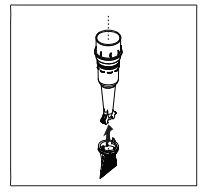
STARTING YOUR WASHING MACHINE
- When loading the clothes into your washing machine, there are four things to remember:
- Clothes must be loaded evenly around the agitator.
- For best result load small items first, followed by large items.
- Clothes must not be wrapped around the agitator.
- For example, a typical load should be loaded using the following sequence : handkerchiefs, wash cloths, undershorts, pillow cases,
- T-shirts, business shirts, tablecloths, sheets, bath towels.
- The washing machine must not be overloaded.
- Clothes must be able to move during wash.
- The load should contain only three or four large items, for example sheets. The rest of the load should be small items. A mixed load of large and small items will wash cleaner than a load of all large items.
ADD THE DETERGENT
- When using the washing machine for the first time,check that the dispenser is set for the type of detergent you will use. To do this, proceed as follows:
- Pull the dispenser drawer forward until it stops.
- Lift the front of the drawer up and forward to remove it from the runners.

- Check the position of the flap at the rear of the detergent compartment in the dispenser drawer.
- Factory setting is flap up for powder.)
- Clip the flap down if you intend to use liquid detergent.
- Remember: If you change the type of detergent you use, the position of the flap will need changing.
- See picture.
- Refit the dispenser back into its runners. clip flap down for liquid
- You are now ready to add detergent.
- Measure the amount required and pour it into the detergent compartment of the dispenser drawer.

ADD FABRIC SOFTENER
- Before adding softener to the dispenser, make sure the siphon cap is pushed firmly down onto the spigot in the drawer.
- The softener will not siphon out if the cap is incorrectly fitted, is missing or blocked with residue. You are now ready to add fabric softener.
- Measure the correct amount as recommended on the softener package into a cup and then pour it into the softener compartment of the dispenser drawer
- Oxygen type - This is generally a powder type bleach. Mix the required quantity with water and pour down the hole in the top panel during the fill when there is some water in the wash bowl.
ADDING BLEACH
- Refer to the instructions on the bleach container.
- Chlorine type - This type of bleach should NOT be mixed with detergent. Mix the bleach with water as per the instructions on the container.
- Turn Program Selector to a Regular Wash position.
- Press the Start/Pasue To Pause touchpad to commence water fill.
- Pour the bleach solution down the hole in the top panel during fill when there is some water in the wash bowl.
- Allow the machine to agitate for a few minutes, then let it stand for the required time by pressing and holding the Start/Pause touchpad for 1.2 seconds to pause machine.
- Turn Program Select to Drain & Spin position and press the Start/Pause touchpad to empty the wash bowl.
- You can now wash the clothes load using detergent and your selected wash program.
SETTING A PROGRAM
- Turn the program selector to the required program.
- The relevant light will light up.
- Your washing machine is now in STAND-BY-MODE and ready to wash your clothes.
- The buzzer will sound.
- Once you selected a program, the program selected will stay at that position for the whole of the cycle.
- The selector dial can be turned either clockwise or anticlockwise.
- The display shows the program duration.
- If you want to define the end of the washing program, press the “Delay End” button repeatedly to choose your machine end time.
- If you want your laundry to be washed with functions different from the one proposed by the machine, press Temperature,
- Water Level, Spin Time and
- Rinse Option buttons.
STARTING A PROGRAM
- When you select the Drain+Spin program, there will be a delay of at least 2 minutes before the washing machine starts to spin.
- This delay is a pump out (Drain) period to ensure the bowl is empty of water, which is necessary before spin commences.
- Even though you may have only put wet clothes into an empty bowl, the delay before spin will still occur to be safe and to protect your washing machine.
INTERRUPTION OF A PROGRAM
- Press the Start/Pause again. The program will continue.
- It is possible to change only before start the program.
- The appliance stops automatically.
- The display will show END ” and with End sound every second in 2 minutes.
- Remove the laundry from the appliance. Make sure that the washing tub is empty.
- Keep the lid ajar, to prevent the mildew and odours.
- Turn the Program Selector knob
Press the ON/OFF button
- Turn off the water tap.
- If you have started your wash and you wish to stop it for some reason, press the Start/Pause button to enter PAUSE mode. The time remaining is shown then “ PAUSE ”.
- You can turn the Program Selector
- Knob to a new program position at any time. If you do move the
- Program Selector Knob the effect will be different depending on the status of the machine at the time you do this, as follows:
AT THE END OF THE AUTO OFF PROGRAM
- When the machine is in PAUSE mode, moving the Knob to a new position 3 short beeps to remind you that cannot change the program in pause mode.
- When the machine is running, moving the Knob to a new position will result in the machine continuing the wash and beeps to remind you that this option is not allowed.
- After 5 min without any user interaction with the appliance, during the machine is in stand by or after the end of the cycle, the appliance receives no further instructions, it will automatically turned Off for energy savings in conformity with the standards on energy consumption).
- All the settings are stored so that when the appliance is turned back on, the program is ready or if the auto-off mode was triggered after the end of the cycle, the user can see that the cycle ended normally, and can restart it.
CARING FOR YOUR WASHING MACHINE
- Your washing machine will give you long and trouble-free service, if you follow the instructions in this section. These instructions show you how to care for your washing machine.
CLEANING THE LINT FILTER
Lint is a collection of threads and fluff which comes off your clothes during washing. Your washing machine collects this lint in the lint fifilter. It is important to clean out this lint fifilter preferably after each wash.
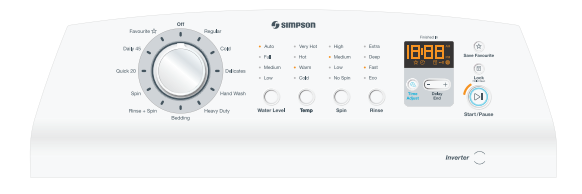
How to clean the lint filter
Remove the Cap Agitator and fifilter column from the centre of the agitator.

Turn the bag inside out and remove the lint.
Wash the fifilter bag and dispenser cup in hot water.
Reassemble the filter to the column and place it back in the centre of the agitator.
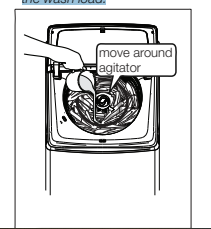
The dispenser needs to be cleaned regularly, preferably after each wash. Inspect the dispenser after each wash to see if there is any residue of detergent.
To do this proceed as follows:
CLEANING THE DISPENSER
- Pull the dispenser drawer forward until it stops.
- Lift the front of the drawer up and forward to remove it from the runners.
- Clean the dispenser drawer with hot water and a brush, eg. an old toothbrush.
- Dry the drawer.
- Before replacing the dispenser back in its recess, clean the inside of the drawer with an old toothbrush.
- Put the dispenser back into its runners and close the drawer.
CLEANING YOUR WASHING MACHINE
- To clean the inside and outside of your washing machine you should:
- Never use solvents, aerosol cleaners, spray pack cleaners, glass, cleaners, metal polishes, caustic materials, scourers or general household cleaners on or near top panel and lid, control panel or other parts of your washing machine.
- Wipe the surface with a mild dishwashing detergent and warm water.
- Wipe dry with a soft cloth.
CLEANING STAINS IN THE
- WASHBOWL metal objects such as bobby pins, dressmaking pins and nails; body oils and grease from very dirty or sweaty clothes being deposited around the top of the washbowl; excessive foam during wash if incorrect or too much detergent is used. salt;
- To avoid this build-up : do not use too much fabric softener with cold water; select a hot water wash at least once a month; always dissolve the detergent in one litre of warm water.
- If you only wash with cold water, undissolved detergent and body oils will build up in the washing machine. This build-up can cause spotting on your clothes.
HELPFUL HINTS IN DEALING WITH WASHING PROBLEMS
Greyness
- Incorrect wash times and using insufficient detergent which can cause redepositing of detergent on clothes.
- Using incorrect type or too much detergent can cause poor rinsing and poor spin performance.
- ONLY use low sudsing, front load washer detergent in this machine, such as Cold Power for Front Loaders and High Efficiency Top Loaders or detergent labelled “Matic”.
- Re-sort load, then re-wash using program selections suitable for the fabric using hot or warm water.
- If the water is very dirty or very sudsy, repeat 2 above reducing the amount of detergent you use.
Yellowing
- A build-up of oils in clothes that come into close contact with the skin, eg underwear, T-shirts.
- Ageing of clothes. Iron deposits in the wash water.
- Use of chlorine bleaches on fabrics with resin finishes.
- Incorrect drying.
- Incorrect water temperatures ie. too hot or too cold.
- Re-sort load, then re-wash using wash program selections suitable for the fabric using hot or warm water.
- If the water is very dirty or very sudsy, repeat 1 above reducing the amount of detergent you use.
- NOTE: Synthetics which have been washed in very hot water will not respond to any treatment
Curries
- Soak/rinse in lukewarm water until a majority of the colour is removed. Sponge with solvent to break down any remaining fats and oils then wash.
- Same as for whites. Check for colour fastness before applying solvent.
Fat/Grease/ Same as for whites.
- Sponge with dry cleaning fluid (white spirits).
- Same as for whites
Fruit
- Sponge with warm water and wash. Bleach remaining stain with oxygen bleach.
- Pour boiling water through stain. Fruit Bleach remaining stain.
Grass, Green Vegetables
- Sponge with methylated spirit. Wash using warm water.
- Same as for whites. Check colourfastness before applying methylated spirit. For acetate, sponge with dry cleaning fluid.
Ice Cream, Cream Milk
- Rinse or soak in cold water then wash. If ice cream contains fruit or chocolate treat as such.
- Same as for whites.
Lipstick
- Rub with lard and wash using hot water. Bleach if necessary.
- Rub with lard and wash using warm water.
Mildew
- Wash using hot water. Moisten with lemon juice and let dry in sun. If stain persists, bleach. Old stains are hard to remove.
- Same as for whites but select water temperature to suit fabric
Mustard
- Wash using hot water and bleach.
- Wash using warm water and use oxygen bleach.
Nail Polish
- Sponge with dry cleaning fluid or nail polish remover. Bleach remove dye.
- Sponge with dry cleaning fluid.
Paint (Oil Based)
- Scrape off fresh paint. Soften dry paint with lard or oil, then sponge with turpentine (turps).
- Same as for whites.
Red Wine
- Rub salt into the stain. Pour boiling water through stain. Bleach if necessary
- Same as for whites
Scorch
- Moisten and place in sunlight. Bleach if necessary. Usually a permanent stain. Brush wools lightly with sandpaper.
- Soak in cool water for 10 minutes. Rub in liquid detergent then wash. If stain persists, try dry cleaning fluid or bleach. Same as for whites - use oxyge
Tomato Sauce
- Soak in cool water for 10 minutes.
- Rub in liquid detergent then wash. If stain persists, try dry cleaning fluid or bleach. Same as for whites - use oxygen type bleach.
Not filling with water.
- Flood.
- Draining problem.
- Loss of water, while washing.
Water level problem.
- Motor fault.
- Lid can’t lock can’t unlock
- Customer action (Summary) Display Code
- Wait a few minutes to see if the fault is corrected.
- If not, press the Start/Pause touchpad and hold it for 1.2 second to enter pause mode then check the drain hose for blockage.
- If the water is pouring onto the floor, turn OFF both wall taps.
- Make sure both wall taps are on and hose filters are not blocked.
Press Start/Pause to continue the wash.
- If problem remains, call Service.
- Raise drain hose if water is flowing out of drain hose.
- Wait a few minutes to see if the fault is corrected.If not, call Service.
- Press Start/Pause to continue the wash.
- If problem remains, call Service.
- If water level in wash bowl is low and water is flooding the floor, turn Program Selector Knob to Spin position, then press Start/Pause To Pause.
- Should this make things worse, press the power button off (some models) and call Service.
Wait, this fault may clear itself.
- If not, turn Program Selector Knob to Spin position, then press Start/Pause to drain the wash bowl.
- If not, turn Program Selector Knob to Spin position to drain the wash bowl.
- If this problem is repeated, call Service.
Wait, this fault may clear itself.
- If this problem is repeated, call Service.
- Press Start/Pause to continue the wash.
Power supply not stable.
- Communication loss.
- Wait until the power supply is stable. turn the machine off and on again
- Old machine
- Ecological hints
- This means that they can be recycled by disposing of them properly in appropriate collection containers.
- Use authorised disposal sites for your old appliance. Help to keep your country tidy!
- The symbol on the product or on its packaging indicates that this product may not be treated as household waste.
- Instead it shall be handed over to the applicable collection point for the recycling of electrical and electronic equipment.
- By ensuring this product is disposed of correctly, you will help prevent potential negative consequences for the environment and human health, which could otherwise be caused by inappropriate waste handling of this product.
- To save water, energy and to help protect the environment, we recommend that you follow these tips:
- Normally soiled laundry may be washed without prewashing in order to save detergent, water and time (the environment is protected too!).
- The machine works more economically if it is fully loaded.
- With adequate pre-treatment, stains and limited soiling can be removed; the laundry can then be washed at a lower temperature.
- Measure out detergent according to the water hardness, the degree of soiling and the quantity of laundry being washed.
See other models: SWF8025DQWA SWF12743 SDV501 SWT8043 SWT6541
